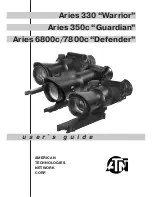
6
4. Now that a distant target is centered in the main tele-
scope’s eyepiece, turn on the red dot finder scope by slid-
ing the power switch to ON (refer to
Figure 11). The “1”
position provides dim illumination while the “2” position
provides brighter illumination. Typically the dimmer setting
is used under dark skies and the brighter setting is used
under light-polluted skies or in daylight. Position your eye
at a comfortable distance from the rear of the unit. Look
through the rear of the finder scope with both eyes open
to see the illuminated red dot. The target object should
appear in the field of view somewhere near the red dot.
5. You’ll want to center the target object on the red dot. To do
so,
without moving the telescope
, use the finder scope’s
vertical and horizontal adjustment knobs (shown in
Figure
11) to position the red dot on the object.
6. When the red dot is centered on the distant object, check
to make sure the object is still centered in the telescope’s
eyepiece. If it isn’t, re-center it then adjust the finder
scope’s alignment again. When the object is centered in
the telescope eyepiece and on the finder scope’s red dot,
the finder scope is properly aligned with the telescope.
The red dot finder scope’s alignment should be checked
before every observing session.
At the end of your observing session, be sure to slide the power
switch on the red dot finder scope to OFF to preserve battery life.
Understanding the “Altazimuth” Mount
The Observer II 70mm Altazimuth refractor features an “altaz-
imuth” mount, which permits motion along two perpendicular
axes: altitude (up/down) and azimuth (left/right) (see
Figure 2).
This makes pointing the telescope easy and intuitive. To move
the telescope in the azimuth direction, loosen the azimuth lock
knob, take hold of the telescope and gently rotate it to the desired
position. Then re-tighten the azimuth lock knob. To move the tele-
scope in the altitude direction, loosen the altitude lock knob then
move the tube up or down to the desired position. Then retighten
the altitude lock knob. If the telescope moves too freely in the
in the altitude direction, then tighten up the yoke knobs a bit.
Of course, you can move the telescope in altitude and azimuth
simultaneously by loosening both of the lock knobs.
Because making fine-adjustments in the altitude of the telescope
can be difficult, the Observer II 70mm Altazimuth refractor comes
equipped with an altitude micro-motion rod and thumbwheel
(
Figure 12). After making coarse altitude adjustments by moving
the tube by hand, you can then move the telescope incremen-
tally by turning the micro-motion rod’s thumbwheel (the altitude
lock knob must be tightened for this). The telescope will move a
very small amount either up or down, depending on which direc-
tion you turn the thumbwheel. Fine motion can be helpful when
centering an object in the eyepiece.
4. Astronomical Observing
For many, this will be your first foray into the exciting world of
amateur astronomy. The following information and observing
tips will help get you started.
Figure 7.
a)
Place the optical tube in the yoke mount, lining up
the holes in the tube’s attachment plates with those in the yoke
mount.
b)
Thread the yoke knob into the threaded hole in the
attachment plates.
Attachment plate
Figure 8
.
a)
Insert the micro-motion rod through the hole in the
metal receptacle on the yoke mount.
b)
Attach the other end of
the rod to the anchor cylinder on the optical tube.
Altitude
lock
knob
Metal
receptacle
Anchor
cylinder
Screw
Figure 9
. Insert the red dot finder scope’s bracket into the base
near the focuser as shown.
Bracket
foot
Finder Scope
Base
a
b
a
b



















